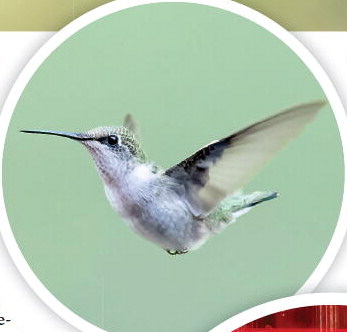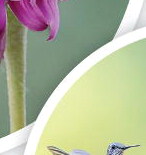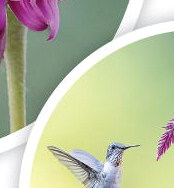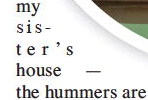From the Porch


fore by and looms utterfly zzing pek-e s if wer. nches I study es me. way — white I hear her before I see her. She hums stops at several blooms on our white butterfly bush before buzzing over to a Mexican petunia stalk and poking her needle-nose beak deeply into the trumpet-like flower. Then she sees me — sitting on the porch wearing a bright fuchsia tee shirt. She’s confused and flies closer to me to see I’m a big pink flower. She hovers ten inches from my face, and her while she studies Then she zooms away a flash of green and iridescent feathers — and the hum of her wings fades to quiet.
A minute later, I see a female hummingbird light on a nearby twig. It’s impossible to know if it is the same one as before. This one stands guard over the butterfly bush. As another hummingbird tries to slip in and sip a little nectar, the perched bird charges into action — buzzing by in an aggressive aerial attack while they both make little twittery squeaks that sound like they are giggling munchkins.
We’ve always hung the feeders around our house and filled them with red sugar liquid, and we’ve always enjoyed watching the hummingbird wars as they battle it out around the yard like avian acrobats. There’s just something about the hummingbirds — something thing otherworld-ly.
There have been years when we’ve hosted up to a dozen of the tiny birds (no larger than my thumb) for the spring and summer seasons, which is why a comment my sister made two weeks ago drew my attention.
“I bet we have 40 hummingbirds right now,” my sister, Audrey, said. “It’s crazy. When I sit on the deck, it’s like watching airplanes take off and land at an airport.”
I had to see the wild spectacle for myself, so I stopped by her house last week. A minute later, I sat on a chair cushion with my mouth hanging open — mesmerized by the number of hummingbirds buzzing here and there and everywhere. It was like someone shook up a snow globe full of miniature hummingbirds. Audrey has her camera mounted on a tris ed ard feeder pended her porch She pod — its len pointed tow a sus over porch. also has some branches mounted here and there so that some of the birds can rest or guard the nectar. With this setup, she has captured some spectacular photos of her hummingbi rd s os y — photos worth of the glossy pages of National Geog ra p h i c or Birds Blooms.
“I think they are all females,” ink
fehe said,
er she waving her hand in the air in a flourish. “The males may be gone by now. They leave earlier than the fe males." I nodded. I've read that the males leave Geor – gia as early as August sometimes, but they'll all be gone soon. In early fall, hummers begin their long, nonstop journey across the Gulf of Mexico to Central America. In the daysleading t h e i r departure, they load up on calo – ries and nutrients. It's not uncommon for humming – birds to double their body weight in preparation for the flight. This is surely what's going on behind my s sis t s t e r ' s house – th h – the hummers are in a feeding frenzy, load – ing up for the long haul to their winter vacation home.
Their wings can beat 50 times per second. Sometimes when I watch these tiny titans hover at a feeder, they don't even look real. They are dronelike. Indeed, they even sound like small mechani –
cal drones.
Flower nectar is not the only food these tiny creatures eat. They also ingest small insects like mosquitoes, spiders, and gnats. They find insect meals in flower blossoms, while other times, they eat them mid flight, like a fly – feathers glitter like jewels in the Georgia sunshine. And did I mention that they are fast – so fast – like jets?
The ruby-throated hummingbirds are just one of the many wonders that grace our planet – a reminder that even the most diminutive among us can accomplish quite marvelous feats.
And so I bid the hum –
mers adieu, and I look for – ward to seeing them again in the springtime, when I'll once again hang my feeders and cherish the simple joy they bring to the world.
Photos by Amber’s sister, Audrey Lanier Andersen, taken from her back deck in Cartersville, Georgia.
catcher. catc o
Like other types of birds, the male is more beautiful than the female. The male boasts the flashy blood-red feathers on his neck, which contrasts boldly with the white feathers beneath the band. T h e i r
&
b
band.
By Amber Nagle
up to to
a l l s c
departure
tiit
glitter like














































































